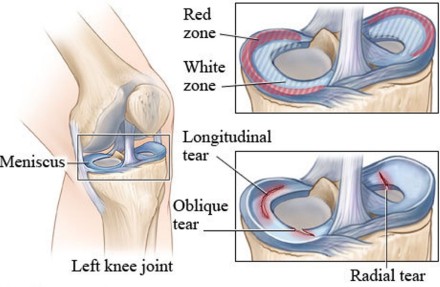
1
X-rays or MRI?
A MRI scan is the most accurate non-invasive test to confirm a meniscus tear. X-rays do not show a meniscus tear.
Does a Meniscus Tear Heal?
Meniscal blood supply is limited: your meniscus receives its nutrition from blood and synovial fluid within the joint capsule. Your meniscus has two distinct regions that affect their ability to heal. We call these the Red Zone and the White Zone.
Treatment Options for a Knee Meniscus Tear
A small meniscus tear, or a tear in the red zone, will usually respond quickly to physiotherapy treatment.
One of the major roles of your meniscus is shock-absorption. Luckily, the other vital shock absorbers around your knee are your muscles. Researchers have discovered that if you strengthening your leg muscles, your bone stresses will reduce as your muscle strength improves and your knee becomes more dynamically stable.
Your physiotherapy treatment will aim to:
- Reduce pain and inflammation.
- Normalise joint range of motion.
- Strengthen your knee: esp quadriceps (esp VMO) and hamstrings.
- Strengthen your lower limb: calves, hip and pelvis muscles.
- Improve patello-femoral (knee cap) alignment.
- Normalise your muscle lengths Improve your proprioception and balance Improve your technique and function eg walking, running, squatting, hopping and landing.
- Minimise your chance of re-injury.
Meniscal injuries are commonly associated with other knee injuries, which need to be treated in conjunction with your meniscal tear.
How Long Does Meniscal Healing Take?
Your meniscal tear will commonly take up to six or eight weeks to fully heal. As mentioned previously, some meniscal tears will require surgery.
Your physiotherapist will guide you as to what is most likely for your knee injury.
It is important to avoid activities and exercises that place excessive stress through your meniscus and further delay your healing. In some cases, your physiotherapist may advise you to keep weight off your knee. In this instances, crutches may be recommended.
Everyone is different, so be guided by your physiotherapist.
Will You Require Surgery for a Meniscus Injury?
Most surgeons will recommend a few weeks of physiotherapy treatment prior to contemplating surgery.
Pre-operative physiotherapy has two main benefits:
- Successfully rehabilitating your knee injury without the need for surgery.
- Strengthening your knee to better prepare you for your post-operative rehabilitation.
If surgery is required, surgery is usually performed arthroscopically (via a fibre-optic camera about the size of a pencil) to either resect (remove) the torn fragment or repair (stitch) a tear in the outer zone.
For similar articles, read Physiotherapy.